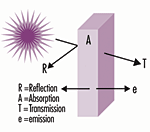Exploring the High-Performance Benefits of Laminated Glass
Versatile Building Material Provides Multiple Advantages
This course is no longer active
|
Portland International Airport
|
| |

The RATe equation
accounts for 100 percent of solar energy,
which is equal to the sum of solar reflectance,
absorption, and transmittance. |
Adding an energy-controlling, or low-e, coating
to a laminated or insulating laminated unit can
provide significant energy-consumption savings,
and the upgrade often rapidly pays for itself. For
example, consider a project incorporating 5,000
square feet of glass in Miami, Florida.
If the architects originally specified one-half-inch
clear laminated glass, the estimated payback period
would be the following:
|
Original Glass Composition
|
Alternate Upgraded
Glass Composition
|
Location
|
Estimated Payback
Period
|
|
½- clear
laminated
½- clear
laminated
|
½- standard
low-e laminate
1-¼"
insulating laminate with hybrid low-e
#2
|
Miami, FL
Miami, FL
|
1.6 years
30. years
|
|
The insulating laminated unit would also offer
the added benefits of a lower U-Value than the
originally specified glass.

Twin
Lakes Park Office Complex, Sarasota,
Florida. Architect: Carlson Studio
Architecture. Photographer: Dick
Dickinson. This LEED-certified
complex uses insulating laminated
glazing units with low-e coatings
to allow maximum daylighting,
minimize energy consumption, and
provide hurricane protection.
|
|
|
|
|
LEED Categories
The U.S. Green Building Council's Leadership in Energy
and Environmental Design (LEED) Green Building Rating System®
was formed to create a consistent green building rating system
and a uniform sustainability building standard. Its goal is
to raise awareness and use of green building methods, by outlining
ways to achieve green building points and ratings. Laminated
glass contributes to several LEED categories, including Energy
and Atmospheric, Materials and Resources, and Indoor Environmental
Quality.
Originally published in Architectural Record.
Originally published in January 2005












